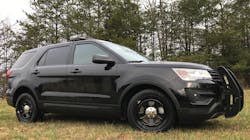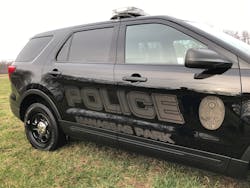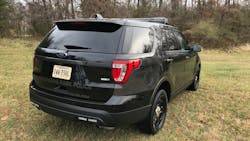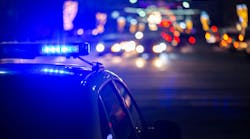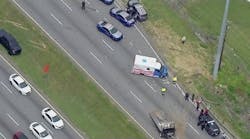The driving public has become quite adept at either recognizing law enforcement patrol vehicles or detecting enforcement activities in such an efficient manner that they can selectively obey the law. Drivers who disobey traffic laws aren’t anything new. Drivers who plan to break the traffic laws, develop strategies and equip themselves to get away with it—now that’s a growing trend. To offset this challenge, law enforcement has had to adapt as well. Two of the largest challenges in this arena are the fact that most law enforcement agencies buy on fleet contracts, so many of the vehicles are the same make and model and the fact that the Commission on Accreditation for Law Enforcement Agencies (CALEA) required front to rear reflective markings as part of the accreditation standard. The second “standard” became so integrated into patrol vehicle design that one media outlet created and published its own requirements as standards for marking a patrol vehicle. Many readers misunderstood and took those published standards to represent some type of requirements for accreditation, legal compliance or other control that mandated such markings.
Ghost Striping a patrol vehicle has become one answer to fully marking a vehicle—but not. Just as emergency lighting evolved so that you can have 360-degree visibility without having the obvious “I’m a police car” lightbar on top, adhesive and reflective markings have evolved as well. The largest manufacturer of these materials today is 3M with their variety of reflective, non-reflective, full-color and no-color or matching-color ghost striping graphics.
Ghost striping has been in use for a few years now and most of you reading this have probably seen a few vehicles marked this way. During the day, unless you look at the vehicle at just the right angle, you can’t see anything but the vehicle’s original color. Law enforcement generally uses vehicles that are all one color and the selection of colors isn’t long: black, white, green, blue, brown or gray. Each year as the color specifications are released by the manufacturers, those in the graphic industry adjust their design software and printers to match the colors with a fairly high level of precision. Then when an agency orders a graphic set based on the year, make and model of the patrol vehicle being marked, the graphic company can provide reflective striping of the same color. As mentioned, in full light, unless you view it from an angle that allows the reflective components to create a different shade of that same color then you can’t see the markings at all. However, once light hits the markings then the reflective components make the graphics highly visible and also add a level of safety via that increased visibility.
That level of visibility is of greatest concern. Thirty years ago, a patrol vehicle was always marked unless it was used for plain clothes or (sometimes) targeted enforcement. There was a time when at least one state police agency rewarded the most effective traffic enforcement trooper with an assigned unmarked car for a month. The thought being that if the trooper could do such a great job in a fully marked car, assigning him (or her) to an unmarked ought to increase efficiency even more. In general, the unmarked cars weren’t as readily recognized as law enforcement vehicles and there were even occasions where offenders charged with fleeing and eluding claimed they didn’t know it was a police car chasing them; and they got away with it.
Ghost Striping bridged that gap from fully marked to unmarked, but in such a way as to not limit the identifying characteristics of the patrol vehicle. This begs the question then: shouldn’t all patrol vehicle be ghost striped? The short answer is no. There are pros and cons to all marking systems and while ghost striping can assist with efficiency in traffic enforcement efforts, they also reduce the overall visibility of the patrol efforts of your agency.
Every Chief, Sheriff, Deputy Chief and Chief Deputy (both terms apply) has had complaints from the public about how they never see a patrol vehicle in their neighborhood or driving by their house. This is far more common in urban areas as the density of population is greater and therefore the density of patrol presence should be increased as well. With a ghost striped patrol vehicle driving down a neighborhood street, the citizens may not recognize it or register it as a law enforcement presence. Remembering that presence is a factor for deterring crime (we all hope), not having that “in your face” full color graphics package on a patrol vehicle does have a potential negative side as well. This demonstrates why not all patrol vehicles should be ghost striped.
There has also been an argument made that ghost striped vehicles are less visible on the road/highway/expressway and are therefore more dangerous for officers to be in or operate. This argument is invalid. When you think about the fact that emergency vehicles are the only vehicles marked at all, this argument would mean that virtually every other vehicle on the road is at a higher risk of not being seen and an equally increased risk of harm to the operator. If such were true, wouldn’t the National Highway Traffic Safety Administration be pushing efforts to have every vehicle fully “marked” with reflective graphics on all sides? If it did and all vehicles were, then the only way to recognize an emergency vehicle would be from the emergency lights when they were activated, along with the accompanying siren.
If you think about it, that’s the equivalent of where a patrol vehicle is if it’s ghost striped and on the highway with every other normal vehicle: no visible markings but fully equipped with lights and siren. Whether the traffic stop being made is during day or night shift, once the patrol vehicle’s emergency lights are activated, at least if it’s equipped properly for 360-degree visibility, whether or not it has markings is irrelevant. It doesn’t matter if it’s day or night, the markings won’t be visible unless light shines on them and that’s true whether the markings are full color or matching/no color ghost striping.
The reasonable conclusion to the question of safety then is that ghost striping has no impact on it. The vehicle is equally visible, day or night, when lights shine on it. Thanks to the emergency lights, day or night, the vehicle should be plenty visible to anyone in the vicinity or driving by. The largest potential impact to be observed by ghost striping patrol vehicles is a lower level of visibility by the public served in a given jurisdiction and it’s up to the administration, via their public information office, to answer such concerns and keep the public informed about the use of such vehicles.
